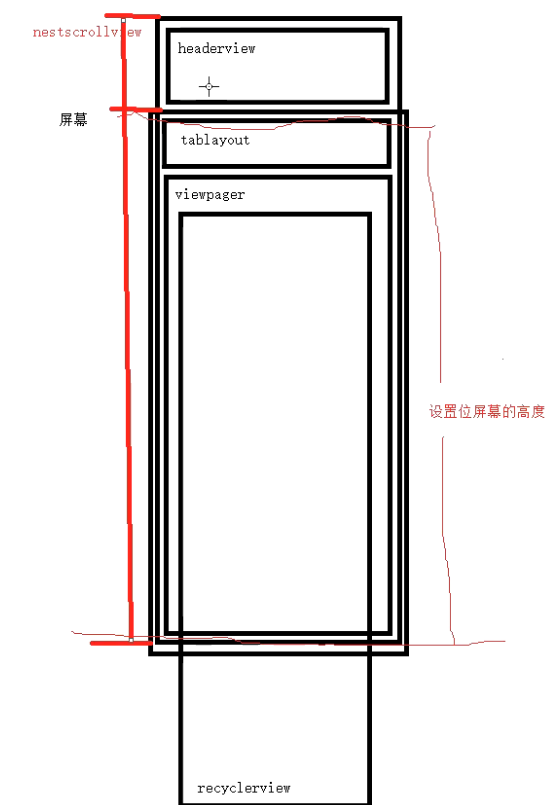Android开发实战——自定义view之京东淘宝首页二级联动
1、布局

2、解决问题
问题1:嵌套滑动冲突
我们知道,通过上面的简单布局,在执行代码的时候,会有滑动冲突产生,当我们滑动recyclerView的时候,headerView不会跟着滑动。
解决办法:嵌套滑动是需要两个角色的,一个是父亲(ScrollView),一个是孩子(recyclerView),我们的recyclerView实现了NestedScrollingChild,而ScrollView并没有实现NestedScrollingParent,因此ScrollView不能作为父亲,而我们的界面用到的是嵌套滑动,嵌套滑动又必须要有父亲,因此我们将ScrollView改成NestedScrollView即可,NestedScrollView实现了NestedScrollingParent接口。此时事件已经被传递,但是没有吸顶。
原因:事件分发原理
问题2:TabLayout吸顶效果
处理方式:
- 固定位置
- 事件拦截
- 备胎(弄两个tabLayout,进行高度计算隐藏和显示)
我们这里用固定位置来做。思路如下:
先看图

我们将NestedScrollView的高度固定,高度等于headerview+屏幕的高度,而屏幕的高度=tablayout的高度+viewpager的高度
当NestedScrollView滑动到底部的时候,也就是headerview全部隐藏的时候,此时tabLayout在屏幕最顶部,NestedScrollView已经滑动到了底部,我们继续滑动屏幕的时候,实际上是在滑动recyclerView,这样tabLayout就会有一个吸顶的效果。
<?xml version="1.0" encoding="utf-8"?> <layout> <androidx.swiperefreshlayout.widget.SwipeRefreshLayout xmlns:android="http://schemas.android.com/apk/res/android" android:layout_width="match_parent" android:id="@+id/swipe_refresh_layout" android:layout_height="match_parent"> <com.nestedscroll.e_perfect_nestedscroll.NestedScrollLayout android:layout_width="match_parent" android:layout_height="match_parent" android:orientation="vertical"> <LinearLayout android:layout_width="match_parent" android:layout_height="match_parent" android:orientation="vertical"> <com.common.views.xxrecyclerview.FixedDataScrollDisabledRecyclerView android:id="@+id/combo_top_view" android:layout_width="match_parent" android:layout_height="wrap_content" /> <LinearLayout android:layout_width="match_parent" android:layout_height="match_parent" android:orientation="vertical"> <com.google.android.material.tabs.TabLayout android:id="@+id/tablayout" android:layout_width="match_parent" android:layout_height="wrap_content" /> <androidx.viewpager2.widget.ViewPager2 android:id="@+id/viewpager_view" android:layout_width="match_parent" android:layout_height="match_parent" /> </LinearLayout> </LinearLayout> </com.nestedscroll.e_perfect_nestedscroll.NestedScrollLayout> </androidx.swiperefreshlayout.widget.SwipeRefreshLayout> </layout>
我们需要自定义一个NestedScrollView,然后重写里面的两个方法
Override protected void onFinishInflate() { super.onFinishInflate(); contentView = (ViewGroup) ((ViewGroup) getChildAt(0)).getChildAt(1); } @Override protected void onMeasure(int widthMeasureSpec, int heightMeasureSpec) { // 调整contentView的高度为父容器高度,使之填充布局,避免父容器滚动后出现空白 super.onMeasure(widthMeasureSpec, heightMeasureSpec); ViewGroup.LayoutParams lp = contentView.getLayoutParams(); lp.height = getMeasuredHeight(); contentView.setLayoutParams(lp); }
当加载完毕之后,获取到NestedScrollView下第0个元素的第1个元素,也就是这段
<LinearLayout android:layout_width="match_parent" android:layout_height="match_parent" android:orientation="vertical"> <com.google.android.material.tabs.TabLayout android:id="@+id/tablayout" android:layout_width="match_parent" android:layout_height="wrap_content" /> <androidx.viewpager2.widget.ViewPager2 android:id="@+id/viewpager_view" android:layout_width="match_parent" android:layout_height="match_parent" /> </LinearLayout>
然后通过onMeasure计算高度。
此时吸顶效果完成。吸顶其实是假象,实际上是NestedScrollView已经到头了,继续滑动屏幕的话实际上滑动的是recyclerView。
问题3:NestedScrollView和recyclerView的滑动没有连接起来
还是回到前面,嵌套滑动是由父亲和孩子两个元素来完成的,所以我们这里需要用子view来主动触发,也就是recyclerView主动触发,NestedScrollView跟随滑动。
因此当NestedScrollView还未处于底部的时候,也就是说NestedScrollView还可以继续滑动的时候,我们需要对滑动进行拦截,告诉recyclerView,父亲滑动就行了,你不用动。
所以我们重写拦截方法onNestedPreScroll,如果不拦截,那么会交给NestedScrollView的父亲去执行,并不是我们想要的
@Override protected void onFinishInflate() { super.onFinishInflate(); topView = ((ViewGroup) getChildAt(0)).getChildAt(0); contentView = (ViewGroup) ((ViewGroup) getChildAt(0)).getChildAt(1); } @Override protected void onMeasure(int widthMeasureSpec, int heightMeasureSpec) { // 调整contentView的高度为父容器高度,使之填充布局,避免父容器滚动后出现空白 super.onMeasure(widthMeasureSpec, heightMeasureSpec); ViewGroup.LayoutParams lp = contentView.getLayoutParams(); lp.height = getMeasuredHeight(); contentView.setLayoutParams(lp); } @Override public void onNestedPreScroll(@NonNull View target, int dx, int dy, @NonNull int[] consumed, int type) { Log.i("NestedScrollLayout", getScrollY()+"::onNestedPreScroll::"+topView.getMeasuredHeight()); // 向上滑动。若当前topview可见,需要将topview滑动至不可见 boolean hideTop = dy > 0 && getScrollY() < topView.getMeasuredHeight(); if (hideTop) { scrollBy(0, dy); consumed[1] = dy; } }
问题4:惯性滑动
思路
- 记下速度
- 转成距离
- 父view滑动了多少距离
- 计算子view该滑动的距离(根据速度转换后的距离-父view滑动了的额距离=子view该滑的距离)
- 子view该滑的距离转成速度(因为recyclerView只有一个fling方法,该方法接收的是一个速度值,因此我们要把剩余的距离转成速度传进去,而不是直接传距离)
下面直接贴代码,代码有注释,配合上面的思路应该就清楚了。
public class NestedScrollLayout extends NestedScrollView { private View topView; private ViewGroup contentView; private static final String TAG = "NestedScrollLayout"; public NestedScrollLayout(Context context) { this(context, null); init(); } public NestedScrollLayout(Context context, @Nullable AttributeSet attrs) { this(context, attrs, 0); init(); } public NestedScrollLayout(Context context, @Nullable AttributeSet attrs, int defStyleAttr) { this(context, attrs, defStyleAttr, 0); init(); } public NestedScrollLayout(Context context, AttributeSet attrs, int defStyleAttr, int defStyleRes) { super(context, attrs, defStyleAttr); init(); } private FlingHelper mFlingHelper; int totalDy = 0; /** * 用于判断RecyclerView是否在fling */ boolean isStartFling = false; /** * 记录当前滑动的y轴加速度 */ private int velocityY = 0; private void init() { mFlingHelper = new FlingHelper(getContext()); setOnScrollChangeListener(new View.OnScrollChangeListener() { @Override public void onScrollChange(View v, int scrollX, int scrollY, int oldScrollX, int oldScrollY) { if (isStartFling) { totalDy = 0; isStartFling = false; } if (scrollY == 0) { Log.i(TAG, "TOP SCROLL"); // refreshLayout.setEnabled(true); } if (scrollY == (getChildAt(0).getMeasuredHeight() - v.getMeasuredHeight())) { Log.i(TAG, "BOTTOM SCROLL"); dispatchChildFling(); } //在RecyclerView fling情况下,记录当前RecyclerView在y轴的偏移 totalDy += scrollY - oldScrollY; } }); }
//获取剩余距离 private void dispatchChildFling() { if (velocityY != 0) { Double splineFlingDistance = mFlingHelper.getSplineFlingDistance(velocityY); if (splineFlingDistance > totalDy) { childFling(mFlingHelper.getVelocityByDistance(splineFlingDistance - Double.valueOf(totalDy))); } } totalDy = 0; velocityY = 0; }
//计算子view滑动的距离 private void childFling(int velY) { RecyclerView childRecyclerView = getChildRecyclerView(contentView); if (childRecyclerView != null) {
//RecyclerView只接收速度参数 childRecyclerView.fling(0, velY); } }
//通过速度计算距离 @Override public void fling(int velocityY) { super.fling(velocityY); if (velocityY <= 0) { this.velocityY = 0; } else { isStartFling = true; this.velocityY = velocityY; } } @Override protected void onFinishInflate() { super.onFinishInflate(); topView = ((ViewGroup) getChildAt(0)).getChildAt(0); contentView = (ViewGroup) ((ViewGroup) getChildAt(0)).getChildAt(1); } @Override protected void onMeasure(int widthMeasureSpec, int heightMeasureSpec) { // 调整contentView的高度为父容器高度,使之填充布局,避免父容器滚动后出现空白 super.onMeasure(widthMeasureSpec, heightMeasureSpec); ViewGroup.LayoutParams lp = contentView.getLayoutParams(); lp.height = getMeasuredHeight(); contentView.setLayoutParams(lp); } @Override public void onNestedPreScroll(@NonNull View target, int dx, int dy, @NonNull int[] consumed, int type) { Log.i("NestedScrollLayout", getScrollY()+"::onNestedPreScroll::"+topView.getMeasuredHeight()); // 向上滑动。若当前topview可见,需要将topview滑动至不可见 boolean hideTop = dy > 0 && getScrollY() < topView.getMeasuredHeight(); if (hideTop) { scrollBy(0, dy); consumed[1] = dy; } } private RecyclerView getChildRecyclerView(ViewGroup viewGroup) { for (int i = 0; i < viewGroup.getChildCount(); i++) { View view = viewGroup.getChildAt(i); if (view instanceof RecyclerView && view.getClass() == NestedLogRecyclerView.class) { return (RecyclerView) viewGroup.getChildAt(i); } else if (viewGroup.getChildAt(i) instanceof ViewGroup) { ViewGroup childRecyclerView = getChildRecyclerView((ViewGroup) viewGroup.getChildAt(i)); if (childRecyclerView instanceof RecyclerView) { return (RecyclerView) childRecyclerView; } } continue; } return null; } }
计算距离的工具类,google自己写的,我直接抄的源码,我专业不是物理,所以这玩意直接抄的。。。。。。
public class FlingHelper { private static float DECELERATION_RATE = ((float) (Math.log(0.78d) / Math.log(0.9d))); private static float mFlingFriction = ViewConfiguration.getScrollFriction(); private static float mPhysicalCoeff; public FlingHelper(Context context) { mPhysicalCoeff = context.getResources().getDisplayMetrics().density * 160.0f * 386.0878f * 0.84f; } private double getSplineDeceleration(int i) { return Math.log((double) ((0.35f * ((float) Math.abs(i))) / (mFlingFriction * mPhysicalCoeff))); } private double getSplineDecelerationByDistance(double d) { return ((((double) DECELERATION_RATE) - 1.0d) * Math.log(d / ((double) (mFlingFriction * mPhysicalCoeff)))) / ((double) DECELERATION_RATE); } public double getSplineFlingDistance(int i) { return Math.exp(getSplineDeceleration(i) * (((double) DECELERATION_RATE) / (((double) DECELERATION_RATE) - 1.0d))) * ((double) (mFlingFriction * mPhysicalCoeff)); } public int getVelocityByDistance(double d) { return Math.abs((int) (((Math.exp(getSplineDecelerationByDistance(d)) * ((double) mFlingFriction)) * ((double) mPhysicalCoeff)) / 0.3499999940395355d)); } }




